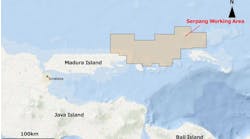FPSO component reflects field, environmental factors
- Computer graphic picture shows how the Banff production unit has changed since its initial concept to a single deck layout bearing the topsides equipment. At the rear there is an aerofoil-shaped mast to keep the vessel trimmed into the prevailing wind and the waves while on station on Banff. the completed vessel was recently launched by the Hyundai shipyard in South Korea, and will shortly sail to the Aker McNulty yard in South Shileds, Uk for topsides installation. [17,8807 bytes]
- Banff Field Ramform FPSO swivel layout. [115,856 bytes]
The challenge is not just for front end engineering contractors, but also for the key production component manufacturers. Brown Brothers, based in Edinburgh, Scotland, supplies multi-path swivel stacks which ensure the transfer of high pressure liquids and gases from seabed wells to FPSOs. System requirements vary appreciably. The latest order is for a completely new type of floater, the Ramform for Conoco UK's Banff Field.
Rather than align itself on an exclusive basis with other contractors offering a complete floating production package, Brown Brothers is working independently. This allows it to supply swivel stacks that are compatible with turrets made by the world's 12 turret manufacturers.
The company began developing a high pressure liquid toroidal swivel in 1985, which was subsequently integrated with the John Hastie-designed in-line swivel technology to produce a combination unit. Its first FPSO order was for the Petrojarl I, which was recently revamped for extended service on Arco British's Blenheim Field.
Brown Brothers in turn were contracted to supply a new multi-path swivel stack, two toroidal swivels and one gas swivel to allow the Petrojarl I to switch to gas lift for oil production. Latter-day North Sea deliveries include Conoco's MacCulloch and BP's Foinaven floaters.
The toroidal swivel can be customized for liquids and gases to meet requirements for varying-sized product lines, flow rates and pressures to be pumped or extracted simultaneously. Path numbers in the swivel are governed by the size and design pressure of each individual pass, limited in turn by the size of the toroidal seal. Electrical power and control line sliprings can be included in the swivel stack, in addition to pneumatic control lines.
Control of the stack - rotation of the inner toroids relative to the outer toroids, as the vessel weathervanes relative to the geostationary flexible risers - can be achieved by an active or passive system, or both, with redundancy built in according to requirements. A typical swivel stack takes 11 months to produce, from procurement to component manufacture, assembly and testing.
A key feature of the swivel stack is its self-alignment capability. "That significantly reduces seal wear," says section leader, product development Magne Hegstad. "If the turret is free-wheeling, rather than locked onto the vessel, a constant movement ensues between the turret and the vessel. With a traditional passive drive, that movement then gets transferred to the swivel stack, so that the dynamic parts of the swivel also move constantly.
"We eliminated these movements by incorporating an active drive on the swivel stack. Only when the vessel is misaligned by more than a pre-set angle can we re-position our swivel. So, instead of rotating back and forth, using a hydraulic drive, you move the swivel in chunks 10-15 degrees.
"This reduces significantly the time the sealing systems and bearings are being moved. But that also depends on how much the ship is weathervaning, and also on the turret - some have low friction bearing and freewheel a lot, while some vessels are configured so that the mooring arrangement transfers movement to the risers."
Banff Ramform
For the Banff Ramform, due to start production next year, the swivel stack will be over nine meters tall, incorporating five toroidal flow paths, an axial gas swivel and an electrical slip ring plus utilities swivel. The weight is approximately 100 tons - fairly standard. It is due to be delivered in March to Aker Maritime Tentech. The turret is also a Tentech design.According to Hegstad, "Each toroidal swivel element is a pressure vessel, exposed to pressure in the pipeline. Within the stack, integrity of the structure depends on environmental forces, G-forces and acceleration forces.
"The G-forces are pretty high on Banff because this is a very short, broad vessel which will move very rapidly in water. The length of the vessel is just 120 meters, compared with 240 meters for the Foinaven FPSO, so it will behave differently. Typically, these vessels are always weathervaning into the wind, with a lot of movement as they pitch into the waves. Foinaven's vessel will experience larger moments and roll angles and higher pitch. But the G-forces are lower than on Banff, as the vessel will be moving slowly."
Banff's five toroidal paths are designed for production, oil export, and water injection. Long-term production plans for Banff are unclear, partly because of the salt diapir overlying the reservoir, which makes field life hard to pinpoint. As main contractor, PGS will also be monitoring reservoir performance during production.
Conoco is covering itself by making allowance for other third party oil discoveries, such as Ranger's Kyle, to be tied in when Banff depletes. "There is a possibility that the swivel stack will be modified and uprated to a larger flow capacity," says Hegstad. One of the water injection swivels is actually dual-purpose - it can be switched to production mode, if necessary. This gives the operator more flexibility in the long run. "We could even fit extra production swivels - with our flexible design, these can be incorporated."
Foinaven's is perhaps a more complex stack, incorporating oil production, gas and water injection swivels plus an electrical slipring, air utility swivel and well test facilities. That's partly because reserves are much higher than on Banff, with the scope of future production expansion still unclear. Conoco's MacCulloch swivel stack was likewise designed with versatility in mind, with the quality and size of the reservoir still unclear. It features similar components to Foinaven's, plus six hydraulic utility swivels as well as a gas export swivel.
The swivel stacks are designed for 20 years or more service, which is twice the lifespan of a typical marginal field. That allows the FPSO owner to reuse them later on another field.
Copyright 1997 Oil & Gas Journal. All Rights Reserved.


